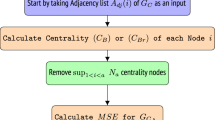Abstract
To investigate the attack and defense strategies in complex networks, the authors propose a two-player zero-sum static game model with complete information which considers attack and defense strategies simultaneously. The authors assume that both the attacker and defender have two typical strategies: Targeted strategy and random strategy. The authors explore the Nash equilibriums of the attacker-defender game and demonstrate that when the attacker’s attack resources are not so significantly abundant as the defender?s resources, there exists a pure-strategy Nash equilibrium in both model networks and real-world networks, in which the defender protects the hub targets with large degrees preferentially, while the attacker prefers selecting the targets randomly. When the attack resources are much higher than defense resources, both the attacker and the defender adopt the targeted strategy in equilibriums. This paper provides a new theoretical framework for the study of attack and defense strategies in complex networks.
Similar content being viewed by others
References
Watts D and Strogatz S, Cllective dynamics of ‘small-world’ networks, Nature, 1998, 393: 440–442.
Barabási A L and Albert R, Emergence of scaling in random networks, Science, 1999, 286(5439): 509–512.
Albert R and Barabási A L, Statistical mechanics of complex networks, Reviews of Modern Physics, 2002, 26(1): xii.
Newman M, The structure and function of complex networks, SIAM Review, 2003, 45(2): 167–256.
Boccaletti S, Latora V, Moreno Y, et al., Complex networks: Structure and dynamics, Physics Reports, 2006, 424: 175–308.
Albert R, Jeong H, and Barabási A L, Error and attack tolerance of complex networks, Nature, 2000, 406(6794): 378–382.
Carlson J M and Doyle J, Complexity and robustness, Proceedings of the National Academy of Sciences of the United States of America, 2002, 99: 2538–2545.
Wu J, Tan Y J, Deng H Z, et al., A robustness model of complex networks with tunable attack information parameter, Chinese Physics Letters, 2007, 24(7): 2138–2141.
Wu J, Deng H Z, Tan Y J, et al., Vulnerability of complex networks under intentional attack with incomplete information, Journal of Physics A, 2007, 40(11): 2665.
Wu J, Barahona, Tan Y J, et al., Robustness of regular ring lattices based on natural connectivity, International Journal of Systems Science, 2011, 42(7): 1085–1092.
Wu J, Tan S Y, Liu Z, et al., Enhancing structural robustness of scale-free networks by information disturbance, Scientific Reports, 2017, 7(1): 7559.
Wang J W, Rong L L, Zhang L, et al., Attack vulnerability of scale-free networks due to cascading failures, Physica A Statistical Mechanics & Its Applications, 2008, 387(26): 6671–6678.
Schneider C M, Moreira A, Andrade J, et al., Mitigation of malicious attacks on networks, Proceedings of the National Academy of Sciences of the United States of America, 2011, 108(10): 3838.
Gao J, Barzel B, and Barabási A L, Universal resilience patterns in complex networks, Nature, 2016, 530(7590): 307.
Liu J G, Wang Z T, and Dang Y Z, Optimization of robustness and connectivity in complex networks, Modern Physics Letters B, 2006, 20(14): 815–820.
Valente A X, Sarkar A, and Stone H A, Two-peak and three-peak optimal complex networks, Physical Review Letters, 2004, 92(11): 118702.
Shargel B, Sayama H, Epstein I R, et al., Optimization of robustness and connectivity in complex networks, Physical Review Letters, 2003, 90(6): 068701.
Liu J G, Wang Z T, and Dang Y Z, Optimization of robustness of scale-free network to random and targeted attacks, Modern Physics Letters B, 2005, 19(16): 785–792.
Peng G S, Tan S Y, Wu J, et al., Trade-offs between robustness and small-world effect in complex networks, Scientific Reports, 2016, 6: 37317.
Hayashi Y and Matsukubo J, Improvement of the robustness on geographical networks by adding shortcuts, Physica A Statistical Mechanics & Its Applications, 2007, 380(1): 552–562.
Li Y, Wu J, and Zou A Q, Effect of eliminating edges on robustness of scale-free networks under intentional attack, Chinese Physics Letters, 2010, 27(6): 068901.
Ash J and Newth D, Optimizing complex networks for resilience against cascading failure, Physica A Statistical Mechanics & Its Applications, 2007, 380(1): 673–683.
Zeng A and Liu W P, Enhancing network robustness against malicious attacks, Physical Review E Statistical Nonlinear & Soft Matter Physics, 2012, 85(6): 066130.
Deng Y, Wu J, and Tan Y J, Optimal attack strategy of complex networks based on tabu search, Physica A Statistical Mechanics & Its Applications, 2012, 442: 74–81.
Tan S Y, Wu J, Lü L Y, et al., Efficient network disintegration under incomplete information: The comic effect of link prediction, Scientific Reports, 2016, 6: 22916.
Holme P, Kim B J, Yoon C N, et al., Attack vulnerability of complex networks, Physical Review E Statistical Nonlinear & Soft Matter Physics, 2002, 65(5): 056109.
Levitin G, Optimal defense strategy against intentional attacks, IEEE Transactions on Reliability, 2007, 56(1): 148–157.
Lü L Y, Chen D B, Ren X L, et al., Vital nodes identification in complex networks, Physics Reports, 2016, 650: 1–63.
Liu J G, Ren Z M, and Guo Q, Ranking the spreading influence in complex networks, Physica A Statistical Mechanics & Its Applications, 2013, 392(18): 4154–4159.
Hausken K, Strategic defense and attack of complex networks, International Journal of Performability Engineering, 2009, 5(1): 13–30.
Osborne M J and Rubinstein A, A Course in Game Theory, MIT Press, MA, 1994.
Acknowledgments
We thank Suo-Yi Tan and Yang Zhang for their helpful insights.
Author information
Authors and Affiliations
Corresponding author
Additional information
This paper was supported by the National Natural Science Foundation of China under Grant Nos. 71871217 and 71371185, and the Natural Science Foundation of Hunan Province under Grant No. 2019JJ20019.
This paper was recommended for publication by Editor SUN Jian.
Rights and permissions
About this article
Cite this article
Li, Y., Deng, Y., Xiao, Y. et al. Attack and Defense Strategies in Complex Networks Based on Game Theory. J Syst Sci Complex 32, 1630–1640 (2019). https://doi.org/10.1007/s11424-019-7420-0
Received:
Revised:
Published:
Issue Date:
DOI: https://doi.org/10.1007/s11424-019-7420-0




